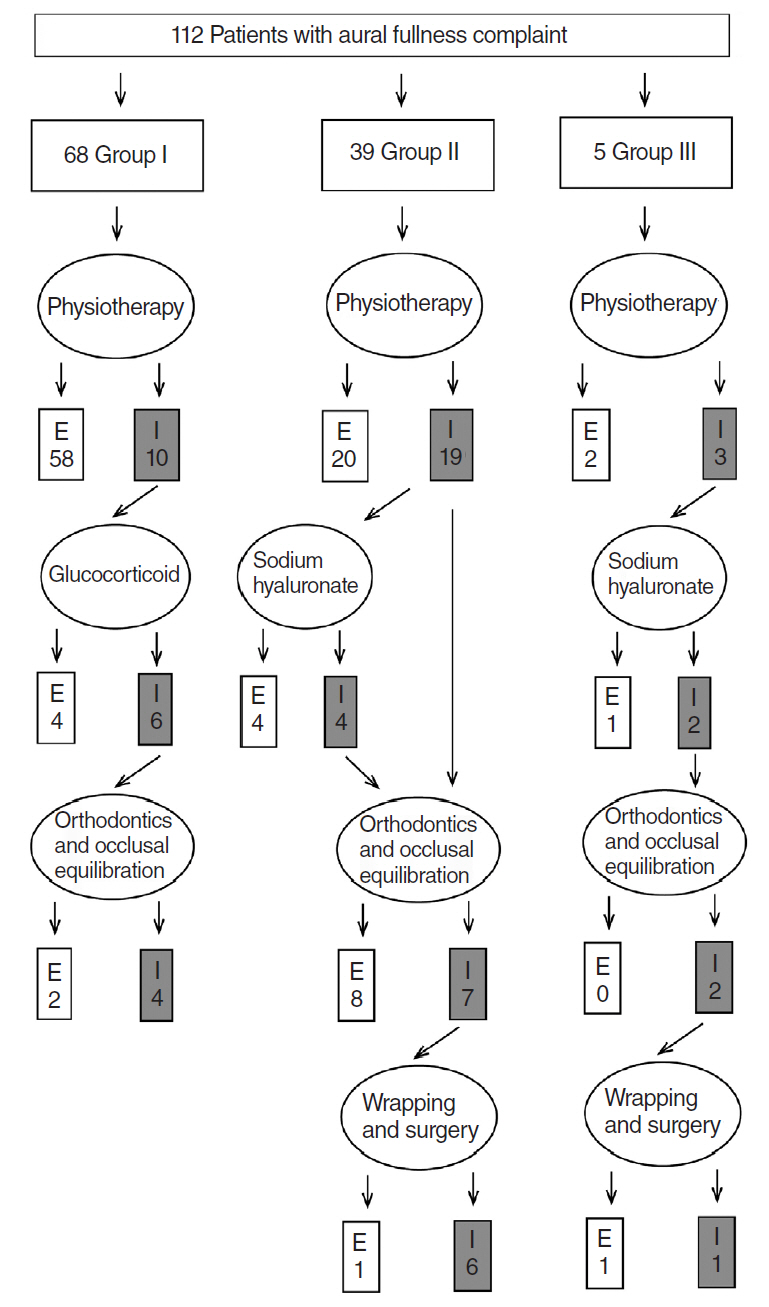Clin Exp Otorhinolaryngol.
2017 Sep;10(3):236-240. 10.21053/ceo.2016.01039.
Temporomandibular Joint Disorders as a Cause of Aural Fullness
- Affiliations
-
- 1Otolaryngology Department, PLA Army General Hospital, Beijing, China. yy20052007@gmail.com
- KMID: 2395737
- DOI: http://doi.org/10.21053/ceo.2016.01039
Abstract
OBJECTIVES
Temporomandibular joint disorders (TMD) are often associated with aural manifestations. However, it is not clear whether aural fullness could be induced by TMD. The purpose was to investigate the TMD and effectiveness of TMD treatments in patients with mainly or exclusively aural fullness complaint.
METHODS
One hundred and twelve patients, who had aural fullness as the main or sole complaint, presented to the Otolaryngology Department, PLA Army General Hospital, Beijing, China, between January 2010 and January 2015. Patients' medical history indicated that they had previously been diagnosed and treated for otitis media or sensorineural hearing loss but without positive results. Patients were subjected to pure tone audiometry and acoustic immittance screening using GSI-61 clinical audiometer and GSI TympStar middle ear analyzer respectively. Patients were examined by questionnaire, X-ray and/or computed tomography scan of temporomandibular joint. TMD was categorized according to the Research Diagnostic Criteria for Temporomandibular Disorders (RDC/TMD). Patients were then treated for TMD.
RESULTS
All the patients showed normal eardrum and type A tympanogram. The patients of 60.7% (68/112) were classified as group I TMD disorders (muscle disorders), 34.8% (39/112) were group II (disc displacements), and 4.5% (5/112) were group III (arthralgia, osteoarthritis, and osteoarthrosis). Aural fullness was completely resolved or significantly improved in 67 and 34 patients respectively following treatments aimed at improving TMD, with a combined effectiveness of 90.2% (101/112). TMD treatments are especially effective (94.1%) in group I TMD.
CONCLUSION
TMD as a potential cause of aural fullness should be considered in otolaryngology practice.
MeSH Terms
Figure
Reference
-
1. Greene CS. Managing the care of patients with temporomandibular disorders: a new guideline for care. J Am Dent Assoc. 2010; Sep. 141(9):1086–8.2. Durham J, Newton-John TR, Zakrzewska JM. Temporomandibular disorders. BMJ. 2015; Mar. 350:h1154.
Article3. Akhter R, Morita M, Ekuni D, Hassan NM, Furuta M, Yamanaka R, et al. Self-reported aural symptoms, headache and temporomandibular disorders in Japanese young adults. BMC Musculoskelet Disord. 2013; Feb. 14:58.
Article4. Buergers R, Kleinjung T, Behr M, Vielsmeier V. Is there a link between tinnitus and temporomandibular disorders. J Prosthet Dent. 2014; Mar. 111(3):222–7.
Article5. Cox KW. Temporomandibular disorder and new aural symptoms. Arch Otolaryngol Head Neck Surg. 2008; Apr. 134(4):389–93.
Article6. Kitsoulis P, Marini A, Iliou K, Galani V, Zimpis A, Kanavaros P, et al. Signs and symptoms of temporomandibular joint disorders related to the degree of mouth opening and hearing loss. BMC Ear Nose Throat Disord. 2011; May. 11:5.
Article7. Tuz HH, Onder EM, Kisnisci RS. Prevalence of otologic complaints in patients with temporomandibular disorder. Am J Orthod Dentofacial Orthop. 2003; Jun. 123(6):620–3.
Article8. Riga M, Xenellis J, Peraki E, Ferekidou E, Korres S. Aural symptoms in patients with temporomandibular joint disorders: multiple frequency tympanometry provides objective evidence of changes in middle ear impedance. Otol Neurotol. 2010; Dec. 31(9):1359–64.9. Dworkin SF, LeResche L. Research diagnostic criteria for temporomandibular disorders: review, criteria, examinations and specifications, critique. J Craniomandib Disord. 1992; Fall. 6(4):301–55.10. Sakata T, Higuchi H, Ueno T, Nakagawa T. Modulation of somatosensory abilities and the feeling of ear fullness in patients with acute sensorineural hearing loss. Auris Nasus Larynx. 2012; Jun. 39(3):265–9.
Article11. Park MS, Lee HY, Kang HM, Ryu EW, Lee SK, Yeo SG. Clinical manifestations of aural fullness. Yonsei Med J. 2012; Sep. 53(5):985–91.
Article12. Dalla-Bona D, Shackleton T, Clark G, Ram S. Unilateral ear fullness and temporary hearing loss diagnosed and successfully managed as a temporomandibular disorder: a case report. J Am Dent Assoc. 2015; Mar. 146(3):192–4.
- Full Text Links
- Actions
-
Cited
- CITED
-
- Close
- Share
- Similar articles
-
- Aural Fullness
- A study on simultation of the mandibular movement of the patients with temporomandibular joint disorder
- The Study for Treatment fo Temporo-mandibular Joint Pain
- A study on the size of condyle and the posterior slope of the articular eminence in patients with temporomandibular joint disorders
- Non-invasive different modalities of treatment for temporomandibular disorders: review of literature


